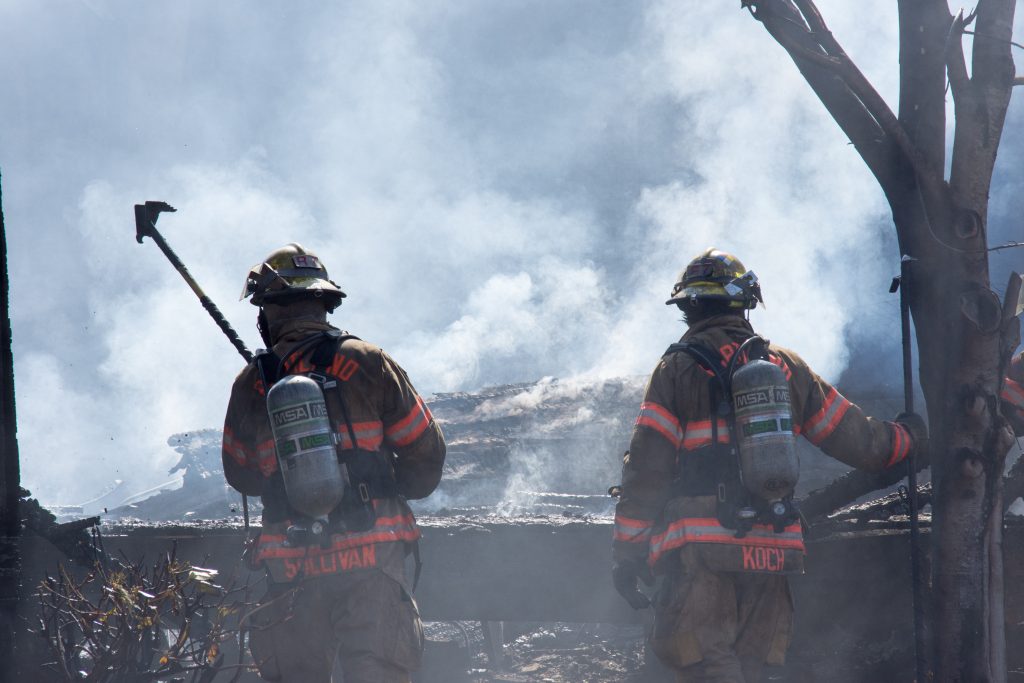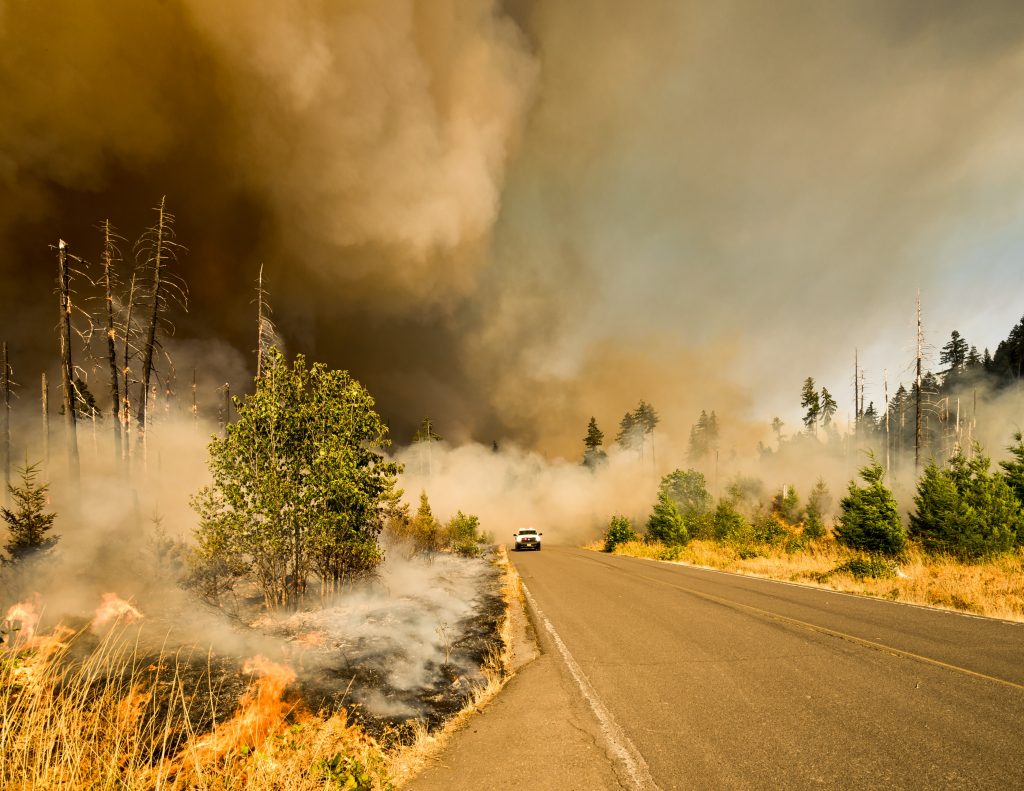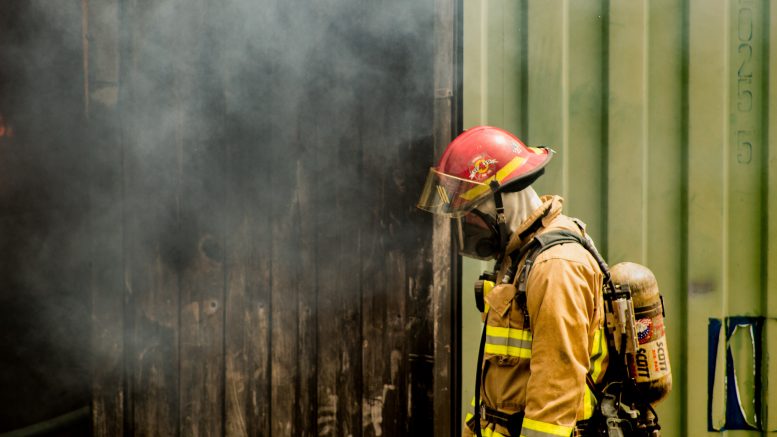By Julie Cart for CalMatters
The morning sun warms California’s high desert, launching a clear spring day. Behind high walls at The Nurturing Nest, across from a burbling mineral pool, a small group of men and women roll up yoga mats and arrange themselves in a semi-circle. Their week at this tranquil retreat is ending and a counselor seeks final thoughts from each of them.
“Why are you here?” the counselor asks a young woman sitting alone on a small sofa, hugging a pillow to her chest. She stares into the middle distance and lets out a deep breath.
“Death. So many deaths,” she said.
The men and women at the retreat are steeped in death:All but one work for Cal Fire, dispatched to the desert as a last resort, seeking release from the neverending pain and fatigue brought on by their jobs.
Defensive and defiant at the beginning of the week, the California firefighters and a dispatcher break down their emotional walls by the end of it, laughing, weeping and recounting once-secret stories about death, terror and fire. They recall horrific sights of friends trapped by flames and reveal their urges to take their own lives.
For firefighters battling California wildfires, these emotional injuries are a workplace hazard. Longer and more intense fire seasons have taken a visible toll on the state, leaving a tableau of charred forests and flattened towns. But they’ve also fueled a silent mental health crisis, including an alarming rise in post-traumatic stress disorder among the ranks of Cal Fire, the state’s firefighting service.
Fifty-four California firefighters have died in the line of duty since 2006, according to the Cal Fire Benevolent Foundation, and nationally, more than 3,000 firefighters have died from job-related injuries and illnesses since 1990.
But when they race into wildfires, it’s not just their bodies that are at risk, but their psyches, too. Wildland firefighters arguably face more psychological stress than most, since their battles are prolonged and their personal risks are high.
“I would be willing to bet that there’s suicidal ideation in half of our employees right now, and half of them have a plan to do it,” said Cal Fire Captain Mike Orton, a former Marine who recently transferred to a Los Angeles County inmate fire camp.
CalMatters interviewedseveral dozen California firefighters — including many high-ranking battalion chiefs and captains — as well as mental health experts and family members, revealing an expansive and unaddressed problem that suggests a broken and depleted fire service is operating in a state that seems in perpetual combustion.
Firefighters, who in the past were stoic and suffered in silence, told CalMatters their emotional and personal stories, revealing their fears that their lack of sleep, long hours and stress could lead to poor decisions on the fire lines — which would endanger not just their crews, but the public, too, as California’s wildfires intensify.
California’s wildfire statistics read like the losing side of an arms race: 2020 was the state’s worst fire season on record, with more than 8,600blazes taking 33 lives and burning 4% of the state. Once-feared megafires are now dwarfed by the state’s million-acre “gigafires.” Climate change has forced wildland firefighters, trained to be nimble problem-solvers, to do a hard pivot. With too few firefighters to cover all the fires, they are on the front lines longer, with shorter respites at home. Some battle fires for months at a time.
The state’s much-admired fire service has only recently tried to come to grips with the scope of the mental health problems among its 6,500 firefighters and support personnel. Cal Fire’s behavioral health program began in 1999 but four years ago had only eight employees, reaching 27 now. Their work is mostly reactive — sending those who actively seek help for their pain, trauma and suicidal throughts to retreats or therapists under contract with the state.

Fatigued, traumatized and frustrated, some California firefighters, including captains and battalion chiefs, say Cal Fire must do more: Staffing shortages create punishing shifts, forced overtime and long deployments. Cal Fire keeps crews on fires for 21 days without respite, while their counterparts with the federal government work 14-day shifts. Those deployments frequently go much longer.
Many suffering from PTSD recount troubles receiving benefits and health care coverage under the state’s workers’ comp system. And some say family members cannot collect survivors’ benefits for a firefighter’s suicide because it’s not classified as a line-of-duty death.
The job strains their marriages and families. One Cal Fire battalion chief in Riverside County, Jeff Burrow, said 80% of his station house crew got divorced in a single year. Sleep deprivation, alcohol and drug abuse are on the rise, firefighters and therapists said.
Many fire station leaders around the state told CalMatters they see an unaddressed epidemic of PTSD and suicidal thoughts among their crews. Yet CalFire does not collect any data on suicide or PTSD within its ranks.
“There’s a lot of people here hurting,” said Tony Martinez, a 29-year veteran Cal Fire captain in Napa County. “It’s an absolute epidemic, it’s not a cliché…The last several years, I’ve had so many coworkers either kill themselves or attempt to kill themselves — in some cases, multiple times.”
Martinez said he “didn’t know it was possible to have PTSD in the fire service. It wasn’t a word that we knew of.” He said he “never saw” PTSD among his colleagues in his first 20 years as a firefighter but he now realizes many of the older veterans’ erratic behavior was the result of years of trauma. “When I reflect back, I think they had PTSD. I think people forever have been suffering in silence.”
Resources Secretary Wade Crowfoot, whose agency oversees Cal Fire, called the mental health of California’s firefighters “a growing challenge. At times it feels like a crisis.”
“We are asking firefighters to fight what are truly catastrophic wildfires,” Crowfoot said. “Every year we are sending thousands of firefighters into intensifying conditions, and more and more dangerous seasons.”
But who will want to battle these fires if these conditions continue?
Several firefighters described high turnover at their stations. And Cal Fire’s statistics suggest that attrition has suddenly worsened: Last year, the number of firefighters and other full-time personnel voluntarily leaving was nearly twice the four-year average, reaching 691 — more than 10% of the agency’s workforce, according to data provided by Cal Fire spokesperson Chris Amestoy.
Martinez said he “bleeds Cal Fire,” but neither of his young adult sons want to follow him into the fire service, and he understands. “I tell my young firefighters: ‘Don’t work here,’ ” he said.
Statistics gauging the extent of the department’s mental health problem are scant: Cal Fire collects no information on PTSD or suicide among its staff so the agency cannot say whether it’s as rampant as firefighters say.
Cal Fire does track the number of times its employees and family members contact a peer-support team for help with an array of issues, primarily physical and mental health. And those numbers have been climbing: from 1,362 contacts in 2011, the first year Cal Fire began compiling the data, to 17,310 last year.
Counselors say a majority of the requests for help are related to stress. So far this year, 24% sought referrals for medical and psychological issues, 12% for grief and loss and about 9% for addiction or substance abuse.

A 2016 report found that nationwide, firefighters are 40% more likely to take their own lives than the general population. In addition, in a 2019 online survey of more than 2,600 wildland firefighters, about a third reported experiencing suicidal thoughts and nearly 40% said they had colleagues who had committed suicide. Many also reported persistent depression and anxiety.
The survey is believed to be the most extensive research into the mental health of wildland firefighters.
Patricia O’Brien, a former federal firefighter who co-authored the study, said the increasing frequency and intensity of California wildfires, coupled with the fire-service ethos of stoicism, is a formula for severe and unresolved trauma.
“This is humans battling a force of nature. We don’t get to conquer nature,” she said. “And if we try to do that, there will likely be negative outcomes in the form of trauma exposure, tragedy and loss. There are human burdens that firefighters carry.”
California’s firefighters carry a heavier burden than most.Unlike the majority of the nation’s wildland firefighters, Cal Fire crews are required to be ambidextrous: They staff local fire agencies in 36 of California’s 58 counties, meaning they toggle from responding to wildfires to hazardous material spills, swiftwater rescues, train crashes and medical emergencies.
“We are humans first, not firefighters or dispatchers,” said Ali Wiseman, a Cal Fire dispatcher who reeled off a cascade of colleagues’ deaths while attending the recent trauma camp in the desert. “Even though it’s hard or painful and embarrassing, I have to trust the world and tell my story.”
Now a year-round, neverending battle
All that the fire service once understood about fire size, behavior and severity is no longer valid. “Once-in-a-career” fires now come every year. What used to be called a fire season is now a year-round battle in California, with about 8,800 wildfires last year alone. Firefighters are staying on the fires lines much longer as they battle larger, more intense and more persistent fires.
In recent years, fire scientists watched as back-to-back fires did the unthinkable, burning across the Sierra Nevada’s granite wall. Lightning sieges sparked fires where flames had seldom been seen, in the North Coast’s “asbestos forests,” dubbed that because they used to be virtually fireproof.


Be the first to comment on "Overworked California firefighters struggle with PTSD, suicide, fatigue, intensifying wildfires"